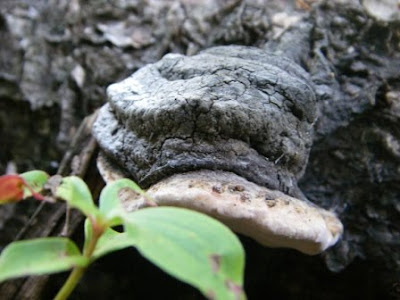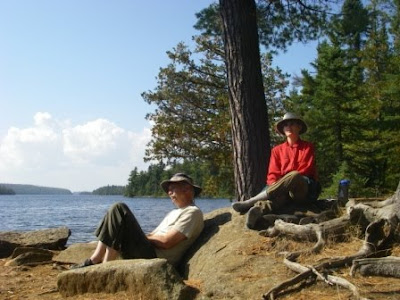 I've been wanting to go to the Boundary Waters for a very long time and have been bugging my friends who go regularly just about as regularly to take me with, but they never took pity on me.
I've been wanting to go to the Boundary Waters for a very long time and have been bugging my friends who go regularly just about as regularly to take me with, but they never took pity on me.(For my non-Minnesotan friends I'll give a bit more background, what it means to be in the Boundary Waters Canoe Area Wilderness at the end of the post.)
So when the MN Rovers beginners trip came up I jumped at the opportunity and couldn't get rid of my deposit check quickly enough!
The trip was fantastic and I loved every minute of it!
I had been a getting a little nervous as departure was approaching. My worries were, that I would do something stupid (i.e. endangering) or that I would be freaked out by the fact that I was committed to the location and the group. I needn't have worried. For starters there were plenty (6) of experienced folks on the trip, who understand the aspects that are new in this experience and who picked a good route to get us three newbies started. The stupidest thing I did was not to pump out the waterfilter after filtering lake water for safe drinking and Barb didn't even raise an eyebrow, so I turned out not to be a menace in the wilderness :-)
First of all: We saw a moose! As we were driving up the Gunflint Trail it crossed the road just after Frank's car and just before Jane's car. Phiew. Big animal, big ears, no antlers, no damage. Cool! My first moose, I was sitting there with my mouth wide open!
The weather was unbeatable! Friday night was a little nippier, but only so you needed another layer and get the stocking hat out and be comfortable again. Hardly any bugs at all and some of the 'squiters were tiny, hardly longer than a fruitfly. The food was yummy, varied and plenty! Thanks to all those who shopped and cooked! The landscape was very samey: Absolutely beautiful! Now the best of the trip was either the company or the pancakes :-)
Thursday Morning at the Poplar Lake put-in: Dividing 10 Duluth packs (="bagzillas") and one duffer between the 4 canoes, while still leaving space for 2 paddlers each...
 Steve, Jessica, Barb and Jane.
Steve, Jessica, Barb and Jane. John, Melissa and Frank.
John, Melissa and Frank.View from our entry point:

At the campsite:
 Melissa B, John H. , Steve, Frank and Jessica.
Melissa B, John H. , Steve, Frank and Jessica.
Our landing: I saw a tiny little crayfish right next to that log.

Lunch at another campsite:
 Melissa, John, Frank, Barb and Jane.
Melissa, John, Frank, Barb and Jane.

Fungi and plants around the campsite:











View from our campsite:

 Jane soaking in sun.
Jane soaking in sun.
Friday's sunset:



Around the campfire: Steve is a great fire cracker, he builds intricate tippees our of pine needles sticks and birch bark that go up in flame like nobody's business. I think he would have also made a good bird.
 Steve, Barb, Melissa and, hmm...
Steve, Barb, Melissa and, hmm...

Saturday morning has broken:

 Jessica with what she rightly called the best pancake she's ever eaten!
Jessica with what she rightly called the best pancake she's ever eaten! Jane, doing anything to get the next pancake with a good helping of boysenberry syrup!
Jane, doing anything to get the next pancake with a good helping of boysenberry syrup! Jessica, the second pancake, Frank the maker of the best pancakes we've ever eaten and Melissa.
Jessica, the second pancake, Frank the maker of the best pancakes we've ever eaten and Melissa. Zooming in on the pancake...
Zooming in on the pancake...View from another beautiful rock landing on lake Winchell. (That campsite was so-so, obscure tent pads and very little privacy on the latrine, not the kind of luxury we had grown accustomed to in our pine-fresh throne cove on our campsite!)




Siesta!
 John and Jane.
John and Jane. Melissa.
Melissa. Jen and Frank off to their next adventure while leaving us lazily dozing in the sun.
Jen and Frank off to their next adventure while leaving us lazily dozing in the sun.Water at the end of the portage.
 I found portaging the canoes strangely empowering! I knew I could carry the 55-60 lb boat for 90-100 rod (320 rod=1 mile), but I didn't expect me to be such good shape afterwards, especially since most portages included inclines, rocks, roots, tree trunks, squishy mud and fallen trees on the path. I was of course puffing up the hills, but I found it really satisfying to know that I can do this. I can hold my own portaging! Nothing can keep me out of the boundary waters now! Hey, even backpacking doesn't seem out of the question anymore. Well, you know, starting with something easy and working my way up.
I found portaging the canoes strangely empowering! I knew I could carry the 55-60 lb boat for 90-100 rod (320 rod=1 mile), but I didn't expect me to be such good shape afterwards, especially since most portages included inclines, rocks, roots, tree trunks, squishy mud and fallen trees on the path. I was of course puffing up the hills, but I found it really satisfying to know that I can do this. I can hold my own portaging! Nothing can keep me out of the boundary waters now! Hey, even backpacking doesn't seem out of the question anymore. Well, you know, starting with something easy and working my way up.



Saturday: Our last sunset for this trip






 Big bug that nearly flew into me.
Big bug that nearly flew into me.
We were all gathered mesmerized by the colors.





 Little toad I found by the red light of my headlamp right next to my water bottles.
Little toad I found by the red light of my headlamp right next to my water bottles.
Sunday morning:


Frank had woken us up at 6am with the plan to head our at 8am and we actually made it 1o minutes ahead of plan!
 Frank and Jen: Setting the pace for the journey home. It took us 4 1/2 hours, hey we were practically high-tailing it out of the boundary waters :-)
Frank and Jen: Setting the pace for the journey home. It took us 4 1/2 hours, hey we were practically high-tailing it out of the boundary waters :-) Melissa and John on a glassy Lake Gaskin.
Melissa and John on a glassy Lake Gaskin. Barb and Steve.
Barb and Steve.
 On the portage: It's not usually that smooth, but that gave me a chance to take a pic of Melissa with bagzilla and framed by early autumn colors, rather than looking on the ground not to topple over roots and rocks.
On the portage: It's not usually that smooth, but that gave me a chance to take a pic of Melissa with bagzilla and framed by early autumn colors, rather than looking on the ground not to topple over roots and rocks.Poplar lake, where we started out and which is not BWCA anymore :-(
 Frank and Jen.
Frank and Jen. John already beyond the wilderness, Melissa still with one foot on BWCAW ground. Steve and Barb.
John already beyond the wilderness, Melissa still with one foot on BWCAW ground. Steve and Barb.It was a good job that Frank made us stay together on Poplar Lake. It is very convoluted with many beautiful islands and many ways to get lost and find very long routes to the take-out.
Puffy cumulus cloud over a string of islands.

It was a very happy weekend!
Many, many thanks to Frank and Melissa for making it happen, for planning a great beginners trip and for all the planning work that you guys no doubt put into it and for organizing rovers gear for us to borrow! And many thanks to Barb, Jen, Jane for bringing essential gear to share! Thanks also to Scott who lent us his nice Kevlar canoe for the trip.
~~~~~~~~~~~~~~~~~~~~~~~
For my non-Minnesotan friends:
The Boundary Waters Canoe Area Wilderness (BWCAW) is a wilderness governed by rules to protect first of all the wilderness and second of all you as a visitor in the wilderness.
1. Leave no trace: Garbage needs to be packed out, meaning that you haul all your garbage back to the car that you left at the put-in and dispose of it after you have left the wilderness. You need to leave your campground as you found it or better. (Cans and glass containers are prohibited.) Tents are pitched on durable surfaces not vegetation. Fires need to be confined to the fire rings and can only be lit, when there isn't a fire ban due to drought. Use biodegradable detergent and use it sparingly and 150 ft (50m) from the waterfront to avoid water contamination. If you need to go to the bathroom, use one of the latrines located on the designated campground or burry and cover it with soil. You can gather dry and dead wood a little bit away from the campsite, but need to leave living plants alone and be respectful of the animals. (Well, ok, mosquitos excluded.)
2. Bear safety: There are black bears in Northern Minnesota. They are swell to live with, as long as you stick to a few rules. Don't startle or even worse trap them, especially when they are protecting a cub. If you back away calmly or make some noise to shoo them away if they are in the campsite they will be perfectly content to go their own way (I am told, I have no experience with bears to date). Keep your food and garbage as well as strong smelling toiletries well stored away while you are not using them. Well stored means either in a sealed bear barrel or hung up in a bag high enough in the tree and far enough apart from the trunk and large branches. The bear barrel is a plastic barrel with a tight sealing lid and a metal ring buckle that bears can't get open and that keep the aluring smells contained within. On our trip we used a dry bag to hang stuff because again that keeps the smell contained and doesn't even attract the bear in the first place versus just leaving him/her frustrated looking up at the bag without being able to get to it. That also means, that you don't want to leave food rests lying around. Best only to cook as much as you can eat because otherwise you need to pack it out and haul it around or burry it at a sufficient depth. You do not want to leave bears with an impression that tent camps are in any way interesting for bears.
3. Keeping it a wilderness: Access to the BWCAW is controled and limited to make sure it doesn't get overrun with too many people in general and in specific spots. In order to enter you need to apply for a permit with date and location of entry. If the maximum number of permits for that location and date have already been issued you need to pick a different location or date for entry. The maximum group size is 9 person/4 canoes. That is also the maximum number of people and watercraft that can be in any one location. So when you see that there are already a maximum number of folks/boats at a landing/site, you need to wait to approach until they have vacated.
There's more too it, but that gives you an idea to start with.












No comments:
Post a Comment